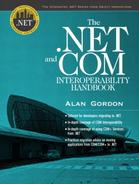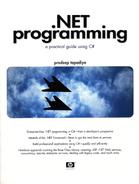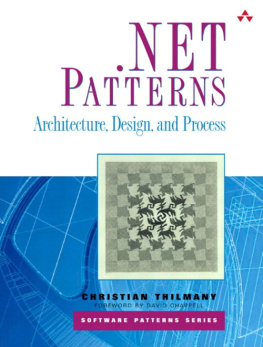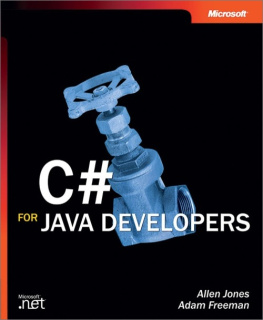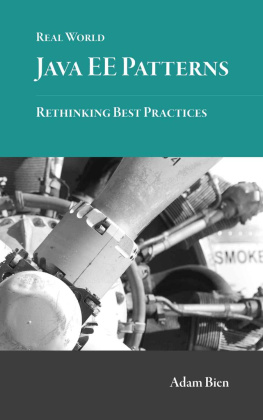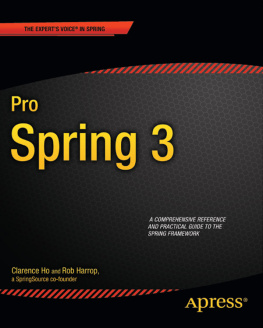Remoting Patterns
Copyright 2005 John Wiley & Sons Ltd, The Atrium, Southern Gate, Chichester, West Sussex PO19 8SQ, England
Telephone (+44) 1243 779777
Email (for orders and customer service enquiries):
Visit our Home Page on www.wileyeurope.com or www.wiley.com
All Rights Reserved. No part of this publication may be reproduced, stored in a retrieval system or transmitted in any form or by any means, electronic, mechanical, photocopying, recording, scanning or otherwise, except under the terms of the Copyright, Designs and Patents Act 1988 or under the terms of a licence issued by the Copyright Licensing Agency Ltd, 90 Tottenham Court Road, London W1T 4LP, UK, without the permission in writing of the Publisher, with the exception of any material supplied specifically for the purpose of being entered and executed on a computer system for exclusive use by the purchaser of the publication. Requests to the Publisher should be addressed to the Permissions Department, John Wiley & Sons Ltd, The Atrium, Southern Gate, Chichester, West Sussex PO19 8SQ, England, or emailed to , or faxed to (+44) 1243 770620.
This publication is designed to provide accurate and authoritative information in regard to the subject matter covered. It is sold on the understanding that the Publisher is not engaged in rendering professional services. If professional advice or other expert assistance is required, the services of a competent professional should be sought.
Other Wiley Editorial Offices
John Wiley & Sons Inc., 111 River Street, Hoboken, NJ 07030, USA
Jossey-Bass, 989 Market Street, San Francisco, CA 94103-1741, USA
Wiley-VCH Verlag GmbH, Boschstr. 12, D-69469 Weinheim, Germany
John Wiley & Sons Australia Ltd, 33 Park Road, Milton, Queensland 4064, Australia
John Wiley & Sons (Asia) Pte Ltd, 2 Clementi Loop #02-01, Jin Xing Distripark, Singapore 129809
John Wiley & Sons Canada Ltd, 22 Worcester Road, Etobicoke, Ontario, Canada M9W 1L1
Wiley also publishes its books in a variety of electronic formats. Some content that appears in print may not be available in electronic books.
Library of Congress Cataloging-in-Publication Data
Vlter, Markus.
Remoting patterns: foundations of enterprise, internet and realtime distributed object middleware / Markus Vlter, Michael Kircher, Uwe Zdun.
p. cm.
Includes bibliographical references and index.
ISBN 0-470-85662-9 (cloth : alk. paper)
1. Computer softwareDevelopment. 2. Software patterns. 3. Electronic data processing Distributed processing. 4. Middleware. I. Kircher, Michael. II. Zdun, Uwe. III. Title.
QA76.76.D47V65 2004
005.1dc22
2004018713
British Library Cataloguing in Publication Data
A catalogue record for this book is available from the British Library
ISBN 0-470-85662-9
Foreword
Many of todays enterprise computing systems are powered by distributed object middleware. Such systems, which are common in industries such as telecommunications, finance, manufacturing, and government, often support applications that are critical to particular business operations. Because of this, distributed object middleware is often held to stringent performance, reliability, and availability requirements. Fortunately, modern approaches have no problem meeting or exceeding these requirements. Today, successful distributed object systems are essentially taken for granted.
There was a time, however, when making such claims about the possibilities of distributed objects would have met with disbelief and derision. In their early days, distributed object approaches were often viewed as mere academic fluff with no practical utility. Fortunately, the creators of visionary distributed objects systems such as Eden, Argus, Emerald, COMANDOS, and others were undeterred by such opinion. Despite the fact that the experimental distributed object systems of the 1980s were generally impractical too big, too slow, or based on features available only from particular specialized platforms or programming languages the exploration and experimentation required to put them together collectively paved the way for the practical distributed objects systems that followed.
The 1990s saw the rise of several commercially successful and popular distributed object approaches, notably the Common Object Request Broker Architecture (CORBA) promoted by the Object Management Group (OMG) and Microsofts Common Object Model (COM). CORBA was specifically designed to address the inherent heterogeneity of business computing networks, where mixtures of machine types, operating systems, programming languages, and application styles are the norm and must co-exist and cooperate. COM, on the other hand, was built specifically to support component-oriented applications running on the Microsoft Windows operating system.
Today, COM has been largely subsumed by its successor, .NET, while CORBA remains in wide use as a well-proven architecture for building and deploying significant enterprise-scale heterogeneous systems, as well as real-time and embedded systems.
As this book so lucidly explains, despite the fact that CORBA and COM were designed for fundamentally different purposes, they share a number of similarities. These similarities range from basic notions, including remote objects, client and server applications, proxies, marshalers, synchronous and asynchronous communications, and interface descriptions, to more advanced areas, including object identification and lookup, infrastructure extension, and lifecycle management. Not surprisingly, though, these similarities do not end at CORBA and COM. They can also be found in newer technologies and approaches, including .NET, the Java 2 Enterprise Edition (J2EE), and even in Web Services (which, strictly speaking, is not a pure distributed object technology, but nevertheless has inherited many of its characteristics).
Such similarities are of course better known as patterns. Patterns are generally not so much created as discovered, much as a miner finds a diamond or a gold nugget buried in the earth. Successful patterns result from the study of successful systems, and the remoting patterns presented here are no exception. Our authors, Markus, Michael, and Uwe, who are each well versed in both the theory and practice of distributed objects, have worked extensively with each of the technologies Ive mentioned. Applying their pattern-mining talents and efforts, they have captured for the rest of us the critical essence of a number of successful solutions and approaches found in a number of similar distributed objects technologies.
Given my own long history with CORBA, I am not surprised to find that several of the patterns that Markus, Michael, and Uwe document here are among my personal favorites. For example, topping my list is the Invocation Interceptor pattern, which I have found to be critical for creating distributed objects middleware that provides extensibility and modularity without sacrificing performance. Another favorite of mine is the Leasing pattern, which can be extremely effective for managing object lifecycles.
This book does not just describe a few remoting patterns, however. While many patterns books comprise only a loose collection of patterns, this book also provides a series of technology projections that tie the patterns directly back to the technologies that employ them. These projections clearly show how the patterns are used within .NET, CORBA, and Web Services, effectively recreating these architectures from the patterns mined from within them. With technology projections like these, it has never been easier to see the relationships and roles of different patterns with respect to each other within an entire architecture. These technology projections clearly link the patterns, which are already invaluable by themselves, into a comprehensive, harmonious, and rich distributed objects pattern language. In doing so, they conspicuously reveal the similarities among these different distributed object technologies. Indeed, we might have avoided the overzealous and tiresome CORBA vs. COM arguments of the mid-1990s had we had these technology projections and patterns at the time.


